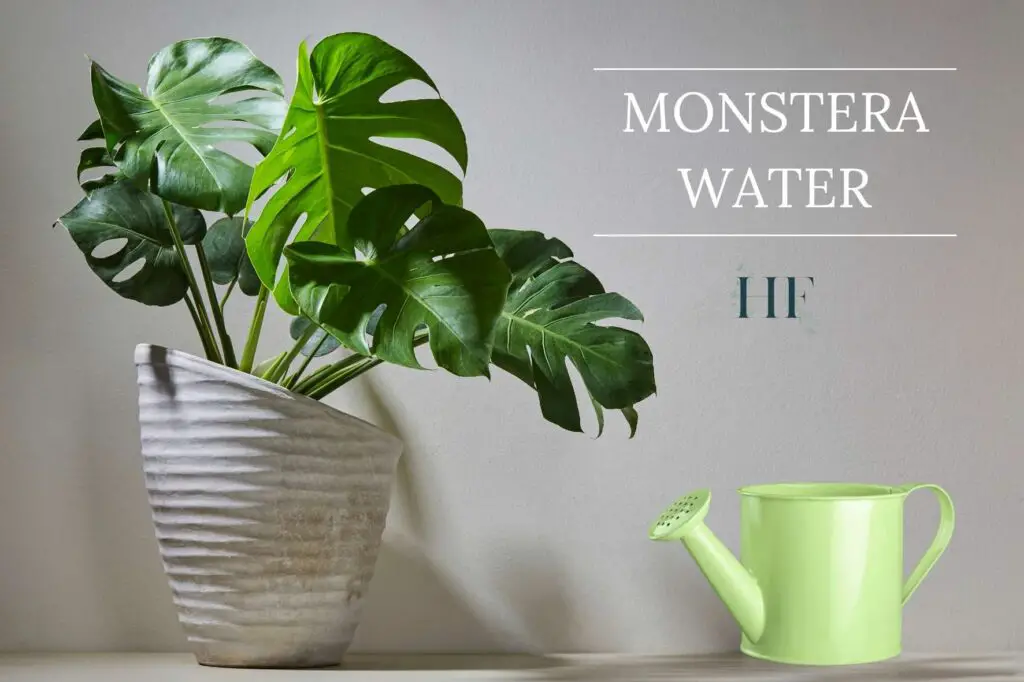Watering is another key factor when caring for plants and one of the most common questions among plant lovers is – how often should I water my Monstera?
Knowing when to water and how often should help you avoid having overwatering and underwatering problems with your Monstera.
Monstera Water Needs
Monstera plants have a moderate water requirement, which means you should water when the soil feels moist one or two inches below the surface.
How can you test this?
There are three ways to test if the Monstera soil is moist:
- Finger test: Gently poke your finger into the soil until you are about 1 inch (2.5 cm) or two knuckles deep. If the soil feels moist, you can hold off on watering. however, if it’s dry, it’s time to water your Monstera.
- Stick method: Insert a wooden stick like a chopstick or dowel into the soil. If it comes out damp with bits of dark soil, the soil is moist and you don’t need to water it. However, if it comes out clean, this means that the soil is dry and it’s time to water.
- Moisture meter method: This is the most accurate method. It gives you a reading of the moisture content of the roots. Simply insert the sensor into the soil halfway between the base of the plant and the edge of the pot and about halfway down into the pot. I recommend this moisture meter. The meter will let you know if the soil is dry (1-3), moist (4-7) or wet (8-10). You only need to water your Monstera when the soil is dry.
How Often to Water Monstera
Should I water my Monstera every day?
Just because Monsteras get frequent rain in their natural habitat (it rains nearly every day all year round), it doesn’t mean you need to water them daily.
As a general rule, you can water your Monstera when the topsoil has dried about 80% of the way, which means that the soil feels moist 1 to 2 inches below the surface. Usually, this happens once a week or once every two weeks.
How often, when and how much you water your Monstera will depend on your plant and its environment.
How Often to Water Monstera in Summer
During the spring and summer months (in the northern hemisphere), you can water your Monstera every 10 to 14 days after checking that the topsoil is dry.
This is a guideline and I’m using a medium-sized Monstera plant as a reference, receiving bright indirect sunlight from an east-facing window.
How Often to Water Monstera in Winter
As a rule of thumb, you should water your Monstera less in winter as they are in their dormant period and their water requirements reduce.
So, during the autumn and winter months (in the northern hemisphere), you can water your Monstera every 14 to 21 days after making sure that the topsoil is dry.
Insider Tip: If it takes longer than two weeks for the topsoil to dry out, you can increase the amount of sunlight your plant receives.
How Often Should I Water My Monstera Adansonii?
You can follow the watering guidelines above for both Monstera Adansonii and Monstera Deliciosa. The key is to confirm that the topsoil is dry before watering any Monstera variety.
That being said, you can water Monstera Adansonii once a week or once every two weeks if the soil is dry.
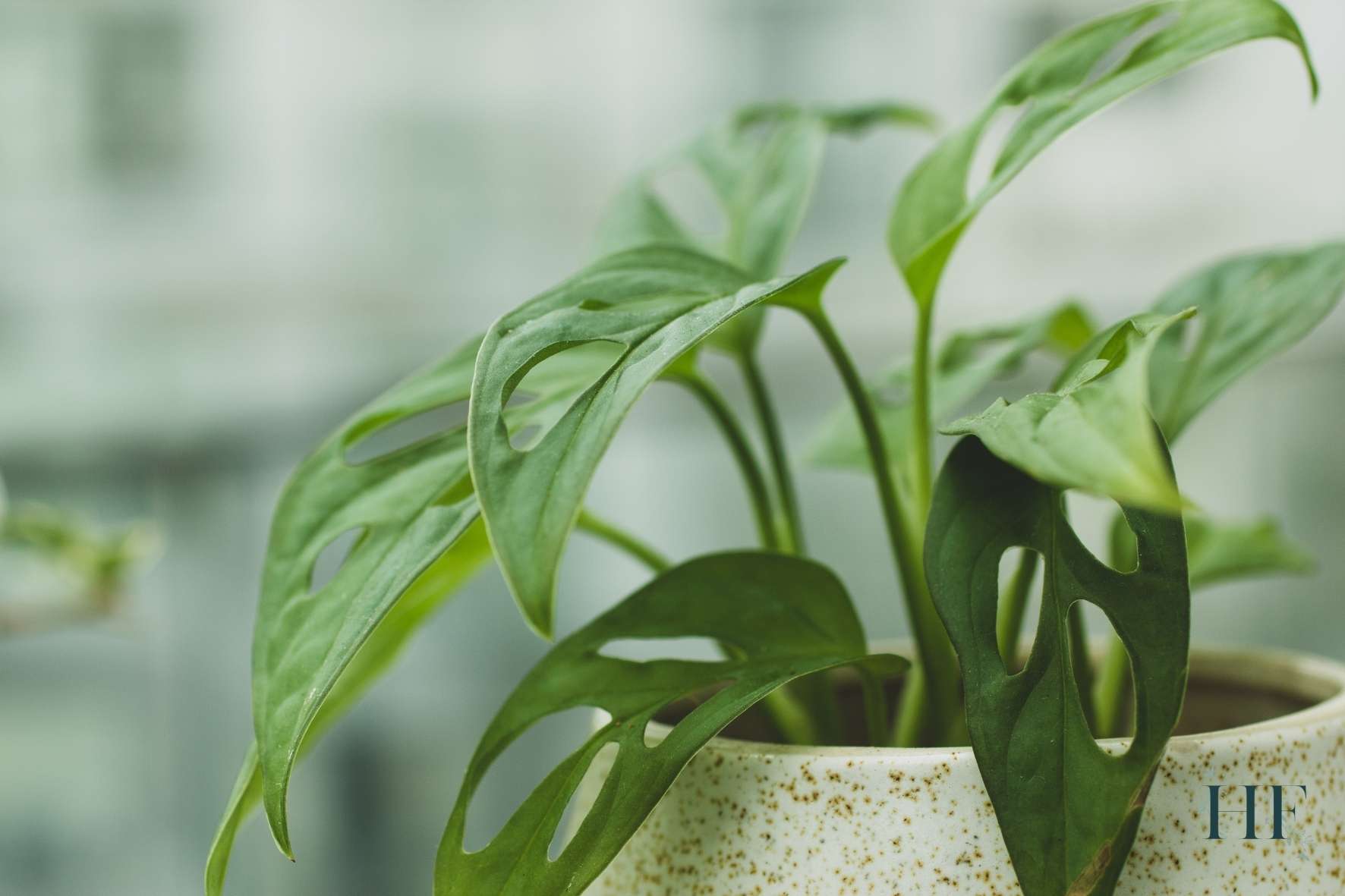
How Long Can Monstera Go Without Water?
Generally, most indoor plants can survive for 7 days without water, some even for 2 weeks!
Also, the more established the plant, the longer it can go without being watered.
If you are going to be away, Monsteras can usually go without water for 2 to 3 weeks as long as you water them thoroughly before leaving and keep them in a humid environment.
When I go on holiday for 7 to 15 days during the summer, this is what I do to keep my plants happy:
1. Water them thoroughly before leaving (if possible, the same morning I’m going away).
2. Group my plants together in the same room where they usually stay.
3. For those close to a window, I half-close the curtains to avoid too much sun and heat to get in.
4. Place some pebble trays under or near the pots.
When possible, ask a friend or family member to water them for you. Leaving clear instructions helps, especially if they are not familiar with your houseplants’ water needs.
Insider Tip: If your Monstera usually stays near a window, you can move it back to avoid it getting too much heat from the window glass.
How Much Water for a Large Monstera?
When watering, you want to make sure that not only the topsoil gets wet, but the bulk of the soil does. That’s why you want to soak the soil thoroughly.
Regardless of the size of your Monstera plant, once the topsoil is dry, you can water it thoroughly until the soil is evenly moist and water runs from the drainage holes.
After watering, avoid the plant sitting in water since it will lead to root rot. So, remove the excess water from the saucer or cachepot (i.e., the decorative planter).
The exact water volume that your Monstera needs will depend on a few factors.
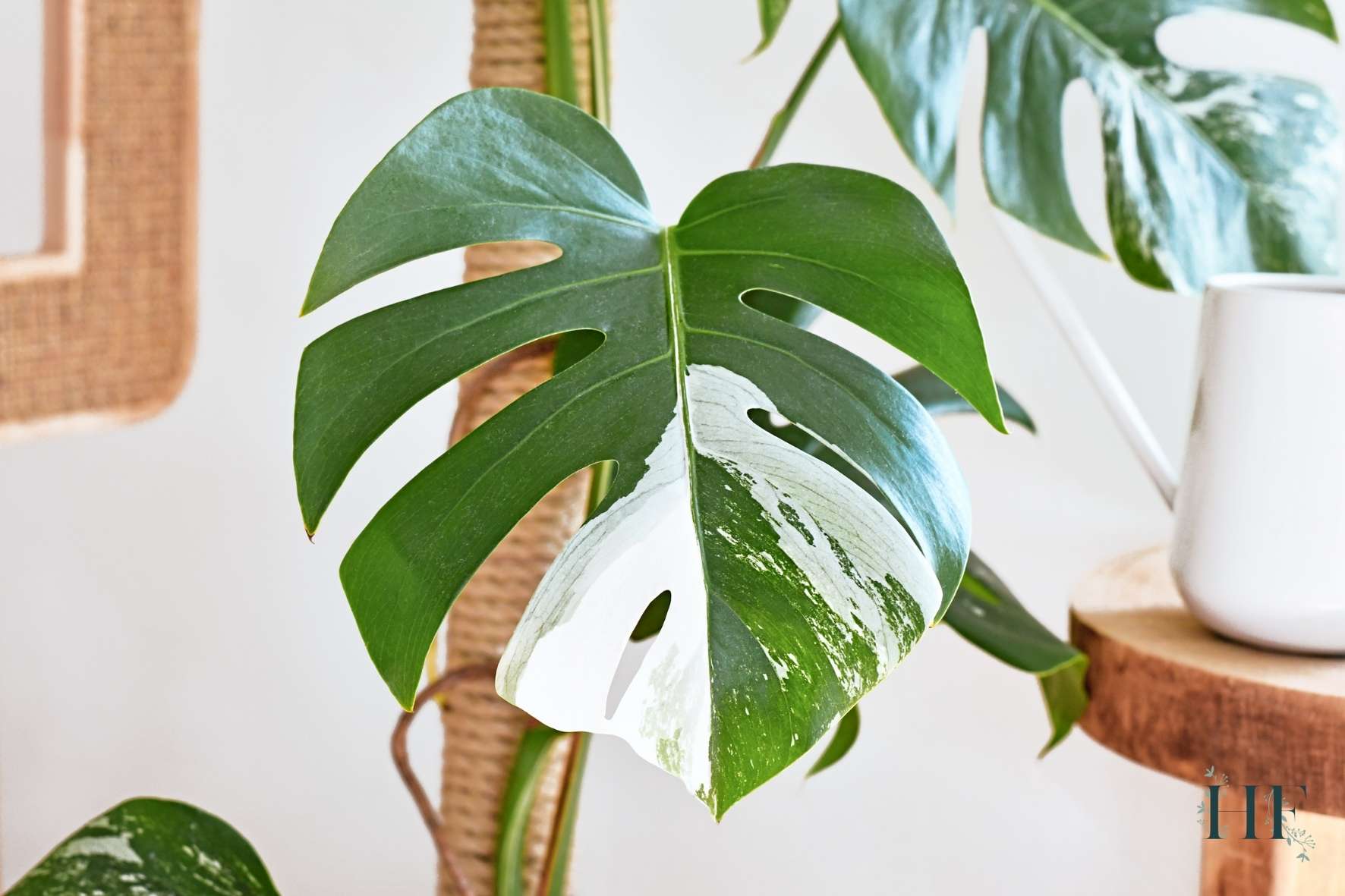
Monstera Watering Factors
The environment where your Monstera lives changes the amount of water that it needs.
So, knowing the factors that will influence how often you need to water your Monstera plants will help you with your watering routine.
Here are the factors that can influence a Montera’s watering frequency:
1) Light, Humidity and Temperature
How much sunlight is available, the humidity levels and the temperature in the area will influence the watering schedule.
Monsteras in bright indirect sunlight will require to watering more often than those displayed in lower light conditions.
In humid conditions, you will water less. In low humidity, you will water more often to maintain soil moisture.
In lower temperatures and colder months, you will water less quantity and less often so the soil has a chance to dry. With warmer temperatures, your Monstera will need water more often.
Also, you will have to increase your watering frequency for Monsteras near fans or heaters which can dry out the soil.
Read also: Monstera Light Requirements – How Much Does It Need? and Monstera Humidity & Temperature Needs – 7 Tips to Get It Right.
2) Soil Type
Monsteras need soil that will retain moisture, yet drains well.
If your Monstera soil is dense, you will need to water it less. However, it may retain too much moisture and leave the roots sitting in waterlogged soil.
On the other hand, lighter potting soil mixes will drain quicker and your Monstera plant might need more frequent watering as a result.
Monstera plants do best in a light, chunky soil mix with a pH of 5.5 to 7. Here are some options to achieve this:
- A mixture of indoor potting soil, a handful of orchid bark chips, loose coco coir, perlite or worm castings.
- A ready-to-go mix of coco coir and perlite and your choice of potting mix for indoor plants. I recommend this organic potting soil mix.
- A Monstera-specific potting soil, which is available on Amazon.
Read also: Which Type of Soil Is Best for Monstera?
3) Pot Size
Larger plant pots will require more water quantity to moisten all the potting soil.
However, your Monstera shouldn’t be in a pot that is too big. A Monstera pot size should be a couple of inches wider than the cluster of roots.
Larger pots hold a lot of soil, which in turn retains a lot of moisture, which increases the chances of overwatering and root rot.
4) Pot Material
The type of pot your Monstera is growing in also affects its need for water.
Generally, you will water your Monstera more often if it’s planted in a porous pot (like terracotta) than those in a non-porous pot (like plastic).
Since plastic pots tend to keep the soil moist for a longer period after watering, I prefer using a clear plastic pot with several drainage holes, which I then put inside a decorative cachepot.
Read also: How to Choose the Best Pot for Monsteras & 10 Planter Ideas.
5) Plant Growth and Seasonality
Finally, the time of the year will also play a part, especially if you experience different seasons where you live.
Most plants, the Monstera genus included, experience growth spurts in spring and summer.
So, you will water your Monstera plants more often during the growing season (spring and summer in the northern hemisphere) to support them during this period of high growth activity.
During autumn and winter, Monstera plants will need less watering since they are mostly dormant and growth slows down. Monsteras usually enter their dormancy period in autumn.
Read also: Monstera Growth Rate, Life Cycle and Lifespan Facts and Tips, which includes 7 tips to encourage your Monstera to grow faster.
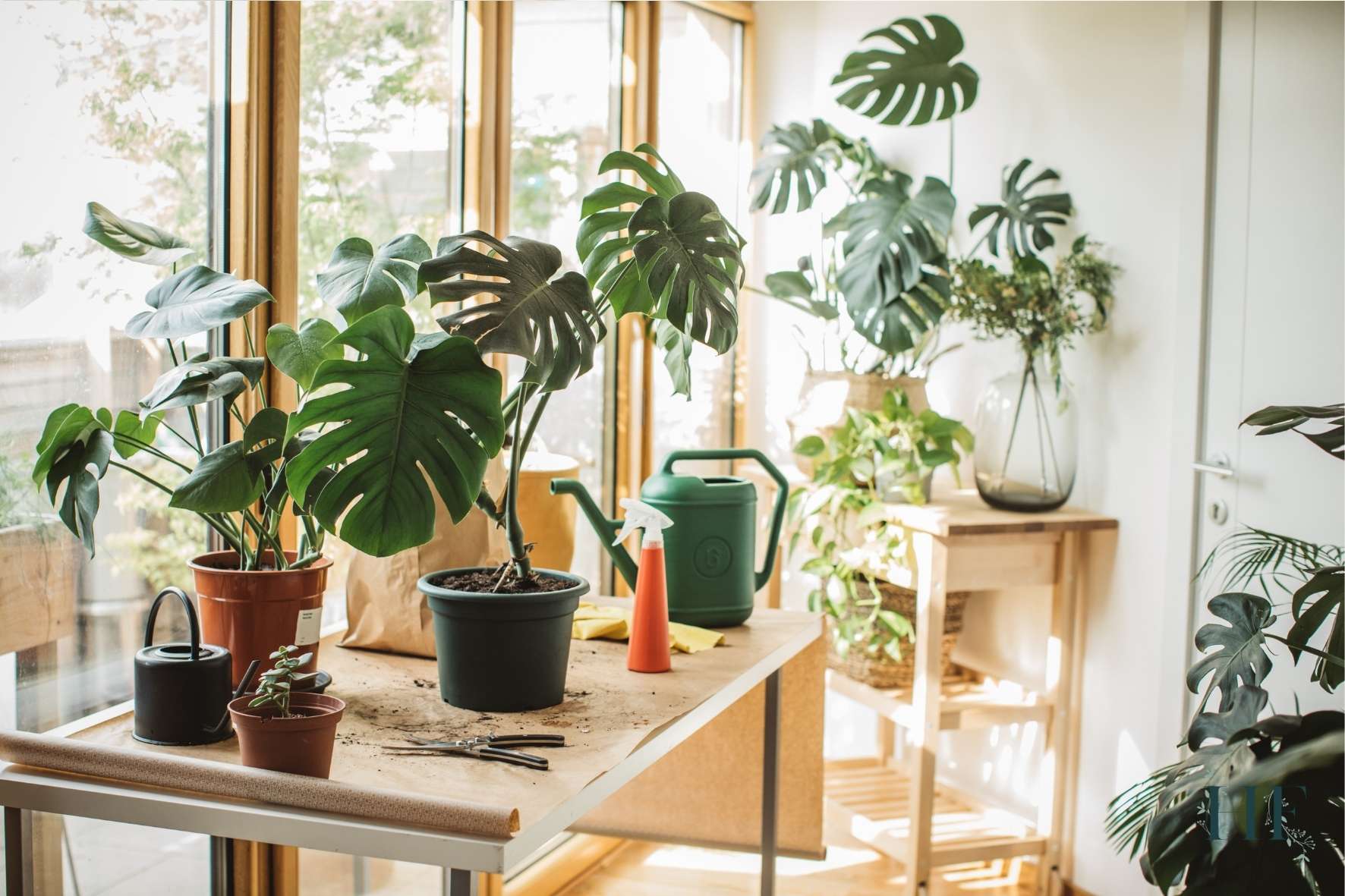
When to Water Monstera
As a rule of thumb, water your Monstera when the topsoil is dry or the soil feels moist one or two inches below the surface.
Also, the best time to water Monsteras (and other plants) is first thing in the morning. This allows them time for the water to run through and be collected. Water retention is generally better in the morning hours before heat or light are at full strength as well.
5 Signs Your Monstera Needs More Water
Monstera plants do a great job of letting you know when they’re thirsty. Here are 5 signs your Monstera needs more water:
1) Monstera’s Soil Is Dry
Dry soil is the main sign that a Monstera plant needs watering. Also, I find it the easiest to recognize.
You can monitor or measure the moisture in the soil using the finger test, the stick method or using a moisture meter, as I explained at the beginning of this article.
For smaller Monstera plants, using the finger test is probably convenient, whereas moisture meters can be very helpful for bigger Monstera plants.
While it’s important to let the topsoil dry out between waterings, a Monstera Deliciosa (and other varieties) shouldn’t be living in dry soil conditions since it will negatively affect its ability to grow efficiently.
2) Monstera Leaves Are Sagging or Wilting
Although I’ve not yet noticed this on my own Mosteras, a leaning Monstera is also a sign of water deficiency.
This sign is similar to wilting in a Peace Lily, Spathiphyllum, for example. An underwatered Monstera will start to sag, as a result, and its stems and leaves will droop. This might be easier to observe on a young Monstera but it can be obvious on larger plants.
If the cause of drooping is too little water, your Monstera should perk back up in a day or two.
3) Monstera Leaves Are Curling
When Monstera plants start to become dehydrated, they will begin to curl their leaves.
Leaves will start to curl inwards, looking smaller and not as wide. After being watered, leaves will return to their natural state in a few days.
4) Monstera Leaves Are Turning Brown, Yellow, or Dying
A healthy Monstera has deep green, waxy leaves (though younger plants or new leaves may be lighter green). However, older leaves will eventually turn yellow and die off, so some discolouration is natural.
However, if you see yellow, brown, or dying leaves in multiple areas of the plant or this is happening to new leaves, you have a problem.
Leaf discolouration is a sign of both underwatering and overwatering.
The first step should always be to check the soil’s moisture level. If the soil is dry, water it thoroughly. If the soil is damp, look for reasons that your plant may be overwatered.
5) Monstera Isn’t Putting Out Fenestrated Leaves
Lack of fenestration is an indicator that a Monstera is not getting enough of something (unless it is a young plant).
Since lack of water is not the only reason, check the soil moisture first before watering and also rule out that it’s not happening due to too little sunlight.
Insider Tip: The clearest sign that a Monstera needs water is dry soil. So, regardless of the other signs you spot, always check the soil before watering.
Also, try to avoid letting Monstera plants get too dry as it will stress the plant and negatively affect its growth.
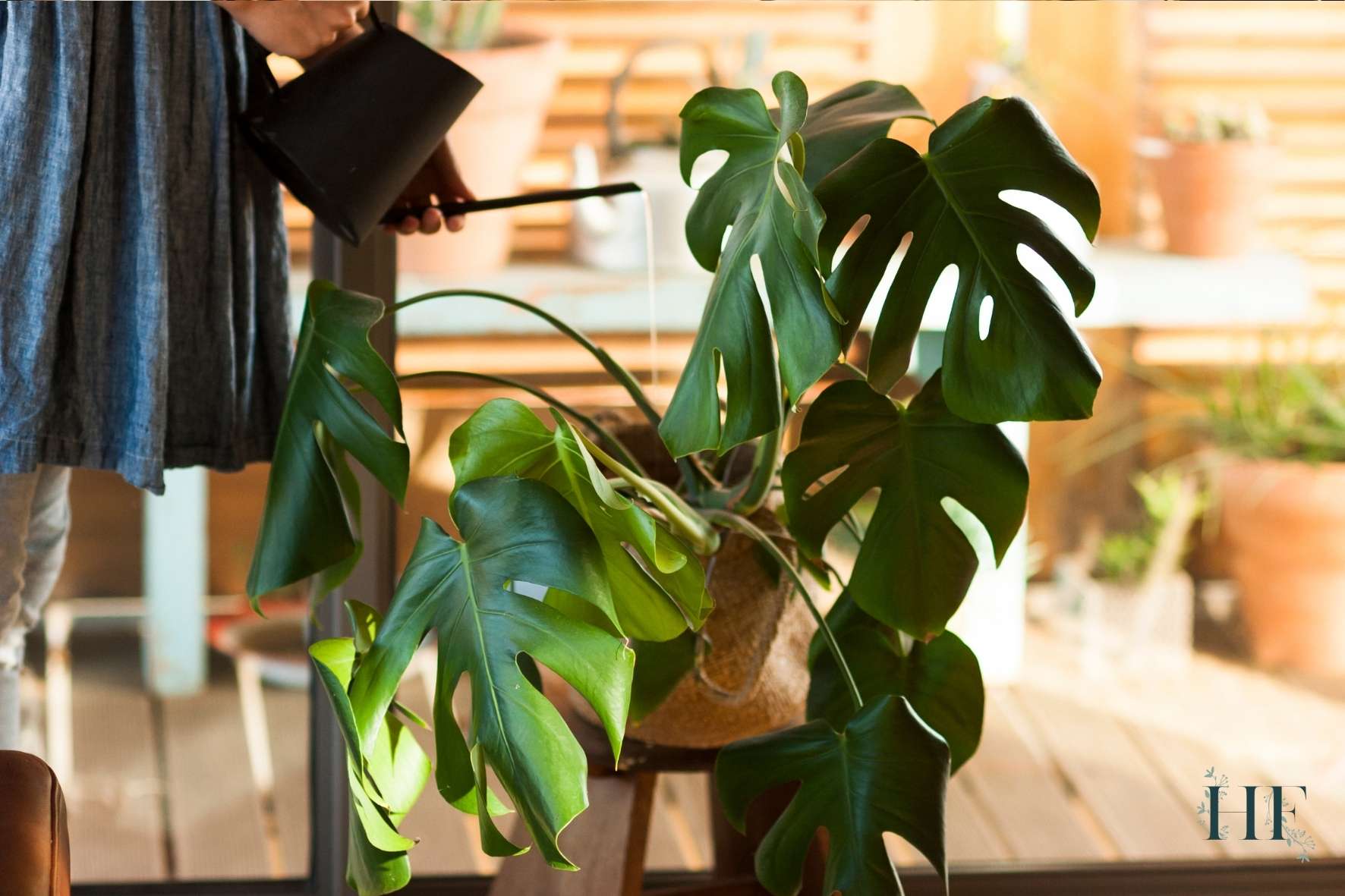
Signs of Overwatering and Underwatering in Monstera Plants
Whilst is great to know when your Monstera needs water, it’s also good to know about overwatering and underwatering signs.
Signs Of Overwatering Monstera
Signs your Monstera is overwatered include:
- Yellowing leaves that become more yellow the more you water the plant.
- Brown leaf tips, particularly on new growth.
- Wilting and drooping despite wet soil.
- Mould on the surface of the soil.
- Mushy stems.
- A rotting smell coming from the soil, this usually indicates root rot.
Signs Of Underwatering Monstera
Signs your Monstera is underwatered include:
- Drooping leaves.
- Curling leaves.
- Brown leaf tips and edges, especially in older foliage. This is a sign of sunburn.
- Wrinkled, crispy leaves, which is another sign of dehydration.
- Dry soil.
- Yellowing leaves.
Insider Tip: It’s better to slightly underwater your Monstera than to overwater it. You can always add more water, but removing water is a lot harder!
Read also: Is My Monstera Overwatered or Underwatered? Signs & How to Fix.
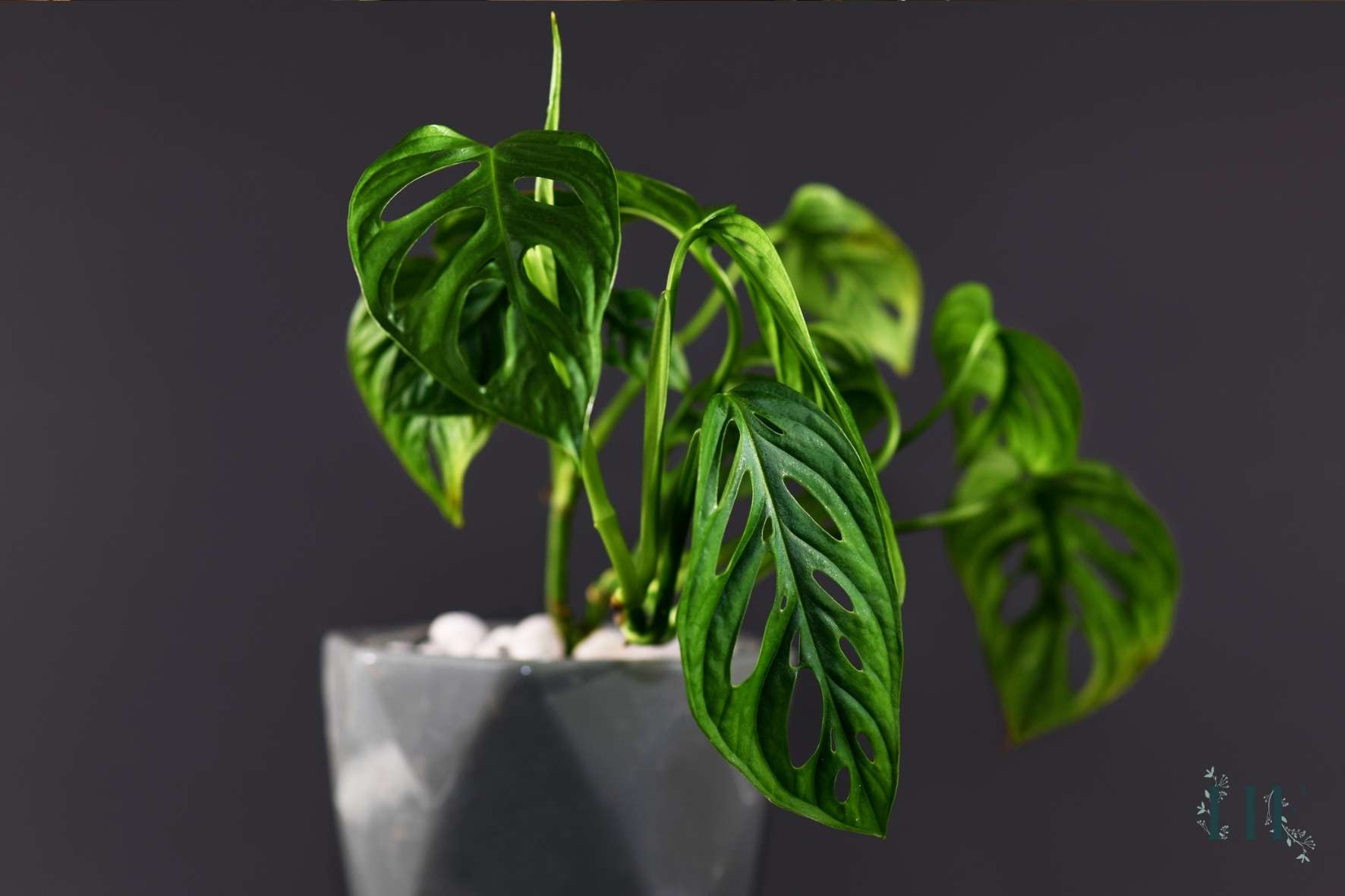
How to Water Monstera
Once you know that your Monstera needs water, it’s time to take action!
What you will need:
- Watering can: A watering can or pitcher will help you direct the water into the soil and avoid wetting the foliage unnecessarily when watering your plants.
- Water: Rainwater and filtered water are the best types of water to use since they don’t contain chlorine or other substances that can damage the cutting.
- Avoid tap water unless you live in an area with high-quality tap water. If you have hard water, the excess buildup of minerals can prevent the plant’s root system from absorbing enough oxygen.
- If you only have access to tap water, leaving it to sit out overnight can allow some of the chlorine to evaporate before you use it.
- Finally, use lukewarm (room-temperature) water when watering your plants to avoid shocking them. Tropical plants may be accustomed to sudden downpours, but the rain is warm, unlike the chilled water from your tap.
Monstera Watering Methods
What is the best way to water a Monstera?
There are two methods for watering Monstera plants: top or bottom watering.
Top Watering Monstera Plants
This is the method I use to water my Monstera plants and almost all of my houseplants.
Here is how to water your Monstera from the top:
- Before starting, make sure you have a saucer or cachepot under the plant pot to catch the water that will flow through the soil.
- Use a watering can or pitcher for watering. This helps direct the water onto the soil and avoid wetting the foliage unnecessarily when watering your plants. Wet leaves in poorly ventilated rooms can encourage your plant to develop diseases.
- Pour the water directly onto the soil, evenly distributing it over the surface area. Since dry soil can often repel water initially, it’s best to pour slowly, so the dry soil has time to absorb the water and becomes evenly moist.
- Keep watering your Monstera plant until water runs freely through the drainage hole at the bottom of the pot and the soil is visibly moist in the pot. This way, you make sure you are thoroughly wetting the soil and water will reach the roots.
- Allow the water to drain for 10 to 15 minutes and then empty the saucer or cachepot. Neglecting to empty the saucer can lead to waterlogged (soggy) soil that cuts off oxygen to the roots of your Monstera plant, leading to root rot.
You can also take your Monstera to the sink to water it using the top method, however, I don’t find it practical (especially for medium to large size plants).
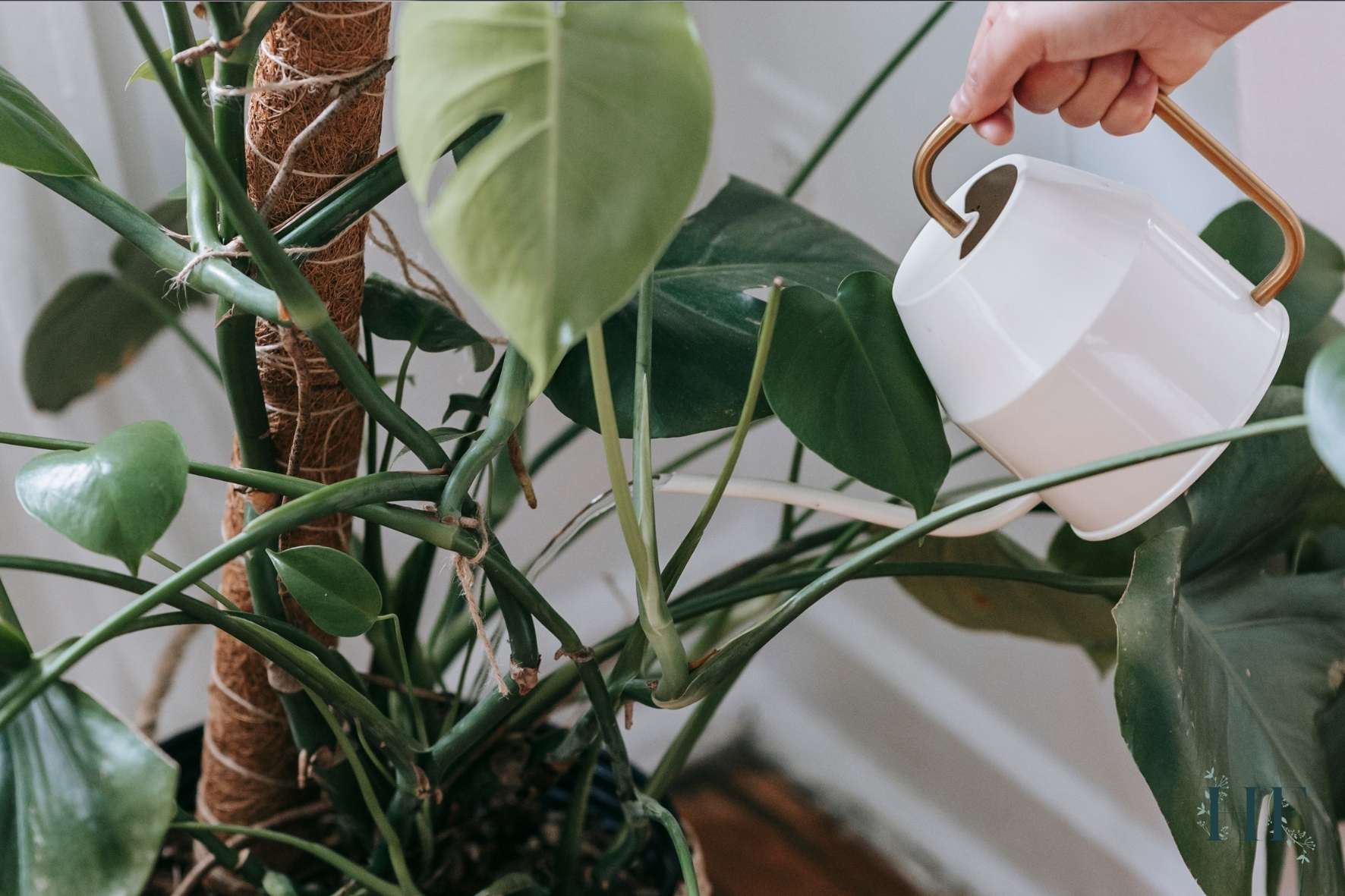
Bottom Watering Monstera Plants
Bottom watering Monstera plants allows the soil to soak up moisture naturally by placing your plant in a few inches of water in a sink or basin.
The main advantage of bottom watering is that it’s a gentle way of watering your Monstera, which avoids washing the important topsoil layer and nutrients out of the soil.
The downside is that this method takes longer. It can take 5 to 20 minutes for a plant to soak up sufficient water to be evenly moist. Also, it’s mostly for small plants since you can only fit a small number of plants in a sink or basin.
Here is how to water your Monstera from the bottom:
- Pour several inches of lukewarm water into a bowl or bucket large enough to accommodate the size of the plant pot. Alternatively, you can use the kitchen sink.
- Remove the saucer or cachepot (decorative pot), so you only submerge the plastic pot that has drainage holes.
- Place your Monstera plant in the water. Make sure the water level is above the bottom of the plant pot and the drainage holes rest in the water.
- Allow your plant to sit in the water until the soil absorbs enough water through the drainage holes to moisten the soil from the bottom all the way to the top.
- Remove the plant from the water and allow any excess water to drain from the pot through the drainage holes, so the soil will not remain soggy. You can tilt the pot to aid this process.
- Return your Monstera plant to its location.
If you are wondering… Should I mist my Monstera? Check out my article on Monstera Humidity & Temperature Needs – 7 Tips to Get It Right, where I answer this question and discuss if misting is effective or necessary.

